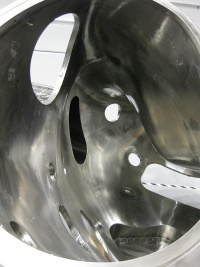Stellarator: Difference between revisions
Jump to navigation
Jump to search
| Line 17: | Line 17: | ||
* [http://www.ipp.mpg.de/ippcms/eng/for/bereiche/e3/projekte/wega.html WEGA] (Germany) | * [http://www.ipp.mpg.de/ippcms/eng/for/bereiche/e3/projekte/wega.html WEGA] (Germany) | ||
* [http://fusion.auburn.edu/ CAT/CTH] (Auburn, USA) | * [http://fusion.auburn.edu/ CAT/CTH] (Auburn, USA) | ||
* [ | * [http://www.fusionvic.org/ UST-1] (Spain, tabletop) | ||
== Future stellarators == | == Future stellarators == | ||
Revision as of 08:12, 23 October 2009
A stellarator is a magnetic confinement device. The rotational transform is predominantly generated by external coils - differently to tokamaks for which the poloidal field is generated by plasma currents. Hybrid concepts employ both external coils and self-generated (boot-strap) currents. An example is NCSX.

Defunct stellarators
- ATF (USA)
- W7-AS (Germany, 1988-2002)
- CHS (Japan)
- NCSX (USA, cancelled before construction was completed)
Operational stellarators
- LHD (Japan)
- TJ-II (Spain)
- HSX (USA)
- H-1NF (Australia)
- TJ-K (Germany) - formerly TJ-IU
- WEGA (Germany)
- CAT/CTH (Auburn, USA)
- UST-1 (Spain, tabletop)